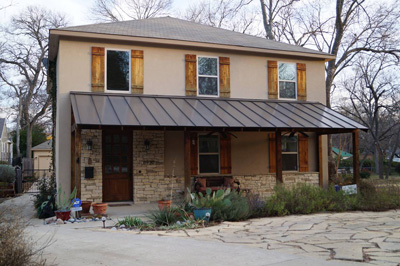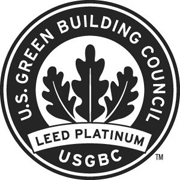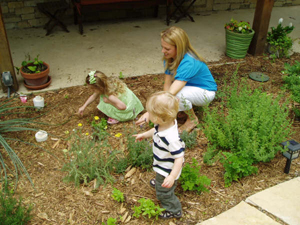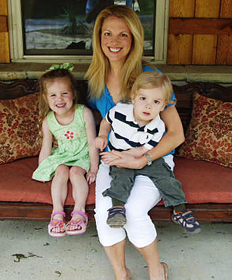By Rita Cook
Here comes spring and what better time to figure out how to “green” your home. No matter what changes you want to make from the small to the more ambitious, you can garner tips from Anna Clark, author of Green, American Style, who owns the second LEED approved home in Dallas. Recently, she shared some of the sustainable choices she's made in her home.

Clark’s LEED Platinum certified home is all about green living, from composting and growing vegetables to xeriscaping and using Green Mountain Energy. It features concrete walls and floors, natural light and very low energy bills.  Clark says that some homes are considered “green” by complying with the ENERGY STAR program, which represents a 15 percent efficiency gain over the model energy code. LEED goes much further, she explains. In her green home tour, she points out that “ENERGY STAR is a good start, but deals with energy consumption only. LEED addresses deeper sustainability concerns such as:
Clark says that some homes are considered “green” by complying with the ENERGY STAR program, which represents a 15 percent efficiency gain over the model energy code. LEED goes much further, she explains. In her green home tour, she points out that “ENERGY STAR is a good start, but deals with energy consumption only. LEED addresses deeper sustainability concerns such as:
- Monitoring waste generated during the building of the site;
- Recycling leftover lumber by shredding it into mulch;
- Using lumber sourced within 500 miles wherever possible;
- Building on a sustainable site, meaning a venue near parks, green space, and public transportation;
- Contributing to urban redevelopment.
 Her house is made with Insulated Concrete Forms (ICFs), which are Styrofoam blocks with concrete poured inside them. The home also has concrete floors, compact florescent bulbs, windows that are vinyl with dual-paned soft coat low-E glass that have a special coating reflecting infrared light, keeping heat inside in winter and outside in summer.
Her house is made with Insulated Concrete Forms (ICFs), which are Styrofoam blocks with concrete poured inside them. The home also has concrete floors, compact florescent bulbs, windows that are vinyl with dual-paned soft coat low-E glass that have a special coating reflecting infrared light, keeping heat inside in winter and outside in summer.
As for the HVAC system, it is a 21 SEER dual-speed condenser sealed combustion furnace. Ninety-five percent of the energy used in the combustion process of the furnace is retained in the home, too.
For air conditioning, the 3,000-square-foot house should require six to seven tons of A/C, but it can be heated and cooled with about two tons. On average, the air conditioner runs at half speed, so the level of efficiency rivals geo-thermal.
The home also has a humidistat and a radiant barrier in the ventilated attic, which keeps out 95 percent of radiant ultraviolet heat from the attic. Tankless water heaters are located on the left side of the house and a hot water heater distributes water through the water distribution maniblock that is located in the mechanical room. There is no big tank of hot water continuously heating it up, the tankless hot water heater operates with a copper coil that super heats water instantaneously and then travels to the maniblock and directly to the fixture for hot water.
Clark says in the kitchen, all the appliances are ENERGY STAR qualified, which use 10 to 50 percent less energy and water than standard models. The gas fireplace burns at 65 percent efficiency and the house is 100 percent wind powered using energy from Green Mountain Energy Company. There is also a small solar panel on the fence in the backyard, which is used to power the gate.
 “In terms of energy efficiency, this house is beyond all standards without exotic technology like solar or geo-thermal,” a tour of Clark’s home narrates. “A high-quality building envelope is the most critical feature to a green home.”
“In terms of energy efficiency, this house is beyond all standards without exotic technology like solar or geo-thermal,” a tour of Clark’s home narrates. “A high-quality building envelope is the most critical feature to a green home.”
Clark says she decided to go green when she had her daughter. “I had my baby and felt an overwhelming desire to protect the earth, or at least change my own relationship with it,” she says.
She believes that everything is connected. “It’s one of the foundational principles of sustainability,” she explains. “I started EarthPeople the year my daughter was born. For her eighth birthday party, she has selected rainforest conservation as her cause. Shark and ocean conservation was the cause last year. To see her heartily embrace conservation advocacy tells me that my work has made an impact where it matters most.”
Note: Clark will be giving a presentation about her home May 18 at 10:30 am in Coppell.
Sign up for the weekly Green Source DFW Newsletter to stay up to date on everything green in North Texas, the latest news and events.
Rita Cook is an award winning journalist who writes or has written for the Dallas Morning News, Focus Daily News, Waxahachie Daily Light, Dreamscapes Travel Magazine, Porthole, Core Media, Fort Worth Star Telegram and many other publications in Los Angeles, Dallas and Chicago. With five books published, her latest release is “A Brief History of Fort Worth” published by History Press. You can contact her at rcook13@earthlink.net









